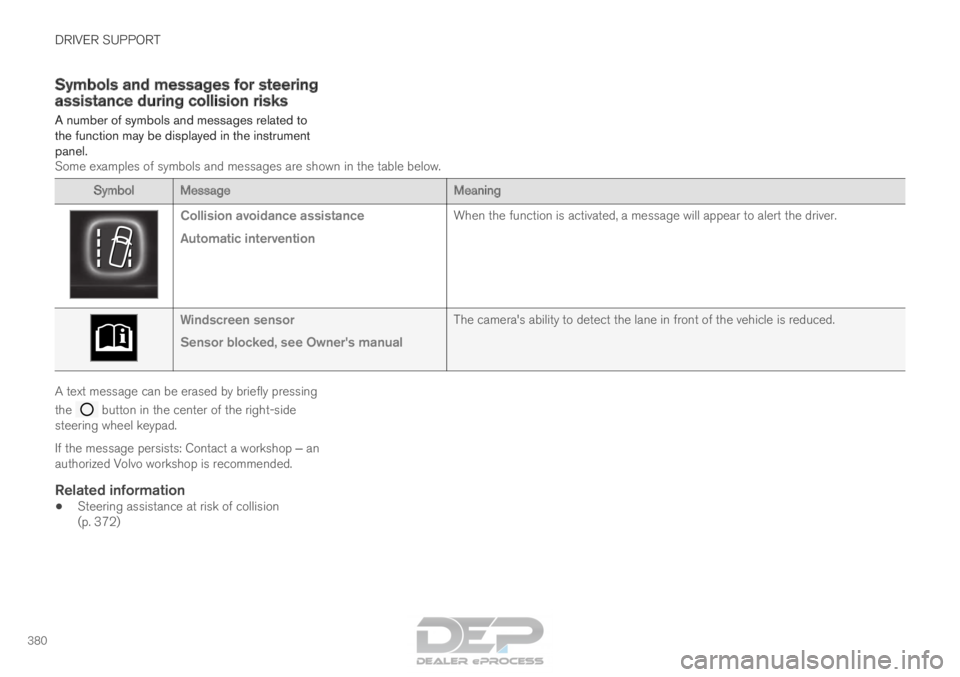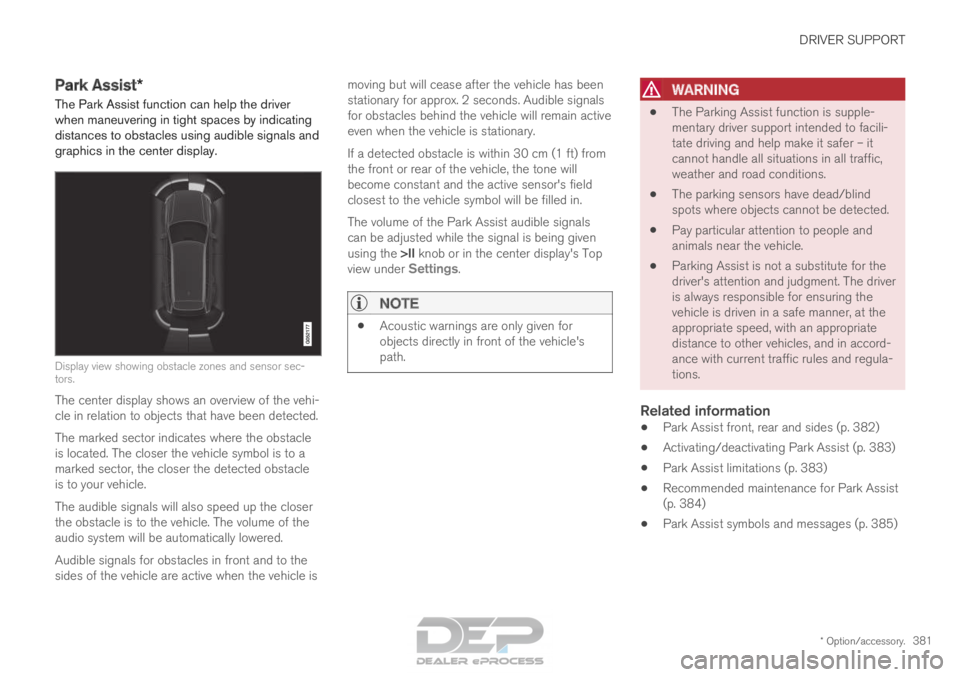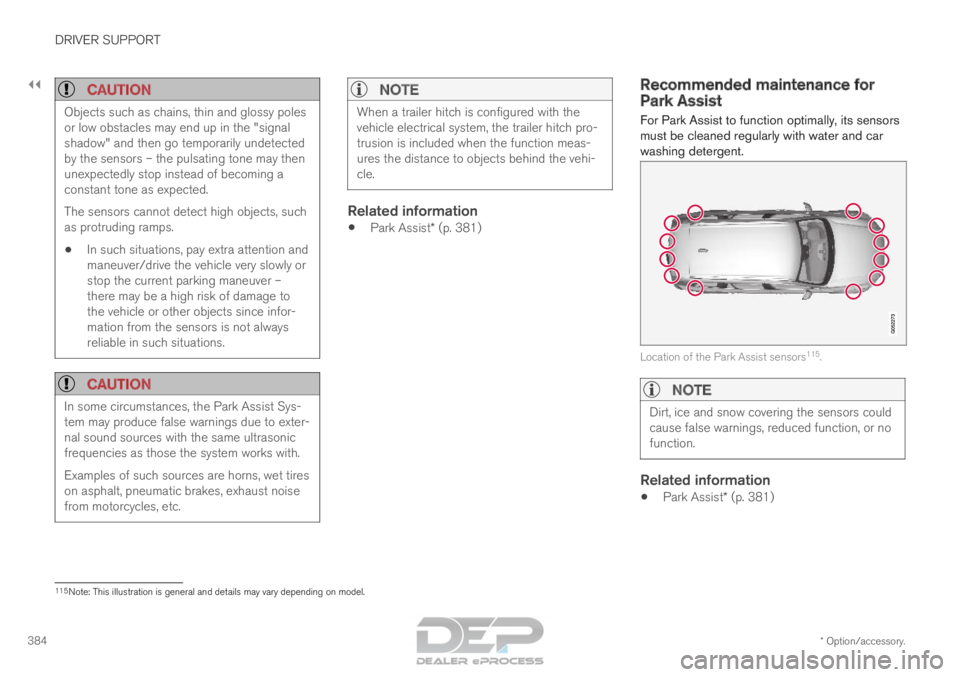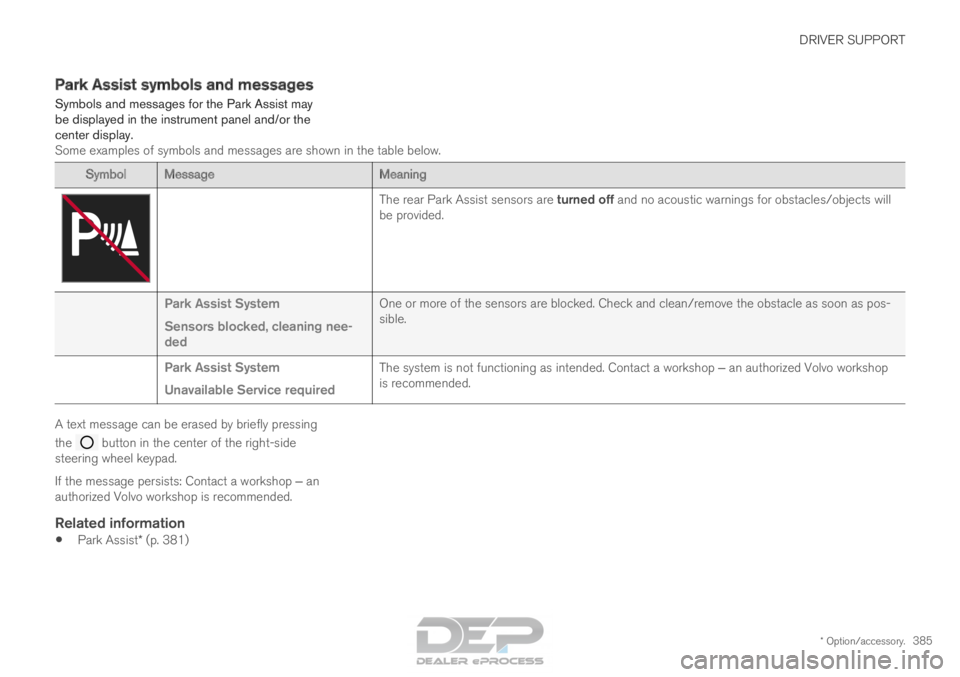VOLVO XC90 TWIN ENGINE 2018 Owners Manual
Manufacturer: VOLVO, Model Year: 2018, Model line: XC90 TWIN ENGINE, Model: VOLVO XC90 TWIN ENGINE 2018Pages: 686, PDF Size: 17 MB
Page 381 of 686

DRIVER SUPPORT
379
NOTEThe function uses the vehicle's camera unit,
which has some general limitations – see the
section "Camera unit limitations".
NOTE
The function uses the vehicle's radar unit,
which has some general limitations – see the
section "Radar unit limitations".
In addition to the camera and radar sensor, the
function also uses the vehicle's rearward-facing
radar, which has certain general limitations the
driver should be aware of. See additional informa-
tion in the section "BLIS limitations".
Related information
•
Steering assistance at risk of collision
(p. 372)
• Speed-dependent steering wheel resistance
(p. 272)
Page 382 of 686

DRIVER SUPPORT
380Symbols and messages for steering
assistance during collision risks
A number of symbols and messages related to
the function may be displayed in the instrument
panel.
Some examples of symbols and messages are shown in the table below.
Symbol
Message MeaningCollision avoidance assistance
Automatic intervention
When the function is activated, a message will appear to alert the drive\
r.Windscreen sensor
Sensor blocked, see Owner's manual
The camera's ability to detect the lane in front of the vehicle is re\
duced.A text message can be erased by briefly pressing
the
button in the center of the right-side
steering wheel keypad.
If the message persists: Contact a workshop ‒ an
authorized Volvo workshop is recommended.
Related information
• Steering assistance at risk of collision
(p. 372)
Page 383 of 686

DRIVER SUPPORT
* Option/accessory.381
Park Assist*
The Park Assist function can help the driver
when maneuvering in tight spaces by indicating
distances to obstacles using audible signals and
graphics in the center display. Display view showing obstacle zones and sensor sec-
tors.
The center display shows an overview of the vehi-
cle in relation to objects that have been detected.
The marked sector indicates where the obstacle
is located. The closer the vehicle symbol is to a
marked sector, the closer the detected obstacle
is to your vehicle.
The audible signals will also speed up the closer
the obstacle is to the vehicle. The volume of the
audio system will be automatically lowered.
Audible signals for obstacles in front and to the
sides of the vehicle are active when the vehicle is moving but will cease after the vehicle has been
stationary for approx. 2 seconds. Audible signals
for obstacles behind the vehicle will remain active
even when the vehicle is stationary.
If a detected obstacle is within 30 cm (1 ft) from
the front or rear of the vehicle, the tone will
become constant and the active sensor's field
closest to the vehicle symbol will be filled in.
The volume of the Park Assist audible signals
can be adjusted while the signal is being given
using the >II knob or in the center display's Top
view under Settings.
NOTE •
Acoustic warnings are only given for
objects directly in front of the vehicle's
path.
WARNING •
The Parking Assist function is supple-
mentary driver support intended to facili-
tate driving and help make it safer – it
cannot handle all situations in all traffic,
weather and road conditions.
• The parking sensors have dead/blind
spots where objects cannot be detected.
• Pay particular attention to people and
animals near the vehicle.
• Parking Assist is not a substitute for the
driver's attention and judgment. The driver
is always responsible for ensuring the
vehicle is driven in a safe manner, at the
appropriate speed, with an appropriate
distance to other vehicles, and in accord-
ance with current traffic rules and regula-
tions.
Related information
•Park Assist front, rear and sides (p. 382)
• Activating/deactivating Park Assist (p. 383)
• Park Assist limitations (p. 383)
• Recommended maintenance for Park Assist
(p. 384)
• Park Assist symbols and messages (p. 385)
Page 384 of 686

DRIVER SUPPORT
382Park Assist front, rear and sides
Park Assist has different parameters depending
on which part of the vehicle is approaching an
obstacle.
Back Note: This illustration is general and details may vary
depending on model.
The rear sensors will be activated if the vehicle
begins rolling backward or if reverse gear is
engaged.
The distance monitored begins
approx. 1.5 meters (5 feet) behind the vehicle.
The rear sensors will be automatically deactivated
if the vehicle is backing up with a trailer attached.
NOTE When reversing with e.g. a trailer or bike car-
rier on the trailer hitch – without Volvo original
trailer cables – the Parking Assist system may
have to be turned off manually to prevent the
sensors from reacting to these.
Side sensors
Park Assist's side sensors are automatically acti-
vated when the engine is started. They are active
at speeds below 10 km/h (6 mph).
The distance monitored begins approx. 30 cm
(1 ft) from the sides. The audible signal for obsta-
cles along the sides of the vehicle is emitted
from the side speakers.
Front camera Note: This illustration is general and details may vary
depending on model.
Park Assist's front sensors are automatically acti-
vated when the engine is started. The front sen-
sors are active at speeds below 10 km/h
(6 mph).
The distance monitored begins approx. 80 cm
(2.5 ft) in front of the vehicle.
NOTE
The Parking Assist system is deactivated
when the parking brake is applied or when P
is selected on vehicles with automatic trans-
mission.
Page 385 of 686

DRIVER SUPPORT
}}
* Option/accessory. 383
CAUTIONWhen installing auxiliary lights: Make sure
these do not obscure the sensors – the auxili-
ary lights could be perceived as an obstacle.
Related information
•
Park Assist* (p. 381) Activating/deactivating Park Assist
The Park Assist Pilot function can be activated/
deactivated.
On/OffPark Assist's front and side sensors are automat-
ically activated when the engine is started. The
rear sensors are activated if the vehicle is moving
backward or reverse gear is engaged.
The function can be activated/
deactivated in the center dis-
play's Function view. –
Tap the
Park Assist button in Function view.
>
The Park Assist Pilot indicator light shows
the status of the function: GREEN (on) or
GRAY (off).
In vehicles equipped with Park Assist Camera,
Park Assist can also be activated/deactivated
from the relevant camera view.
Related information
• Park Assist* (p. 381) Park Assist limitations
Park Assist may not be able to detect all condi-
tions in all situations and functionality may there-
fore be limited in certain cases.
The driver should be aware of the following limi-
tations for Park Assist:
WARNING Be extra cautious when
reversing if this symbol is
shown when a trailer, bike
carrier or similar is attached
and electrically connected
to the vehicle.
The symbol indicates that
the rear parking assist sensors are deacti-
vated and will not warn of any obstacles.
Page 386 of 686

||DRIVER SUPPORT
* Option/accessory.
384
CAUTION Objects such as chains, thin and glossy poles
or low obstacles may end up in the "signal
shadow" and then go temporarily undetected
by the sensors – the pulsating tone may then
unexpectedly stop instead of becoming a
constant tone as expected.
The sensors cannot detect high objects, such
as protruding ramps.
• In such situations, pay extra attention and
maneuver/drive the vehicle very slowly or
stop the current parking maneuver –
there may be a high risk of damage to
the vehicle or other objects since infor-
mation from the sensors is not always
reliable in such situations.
CAUTION In some circumstances, the Park Assist Sys-
tem may produce false warnings due to exter-
nal sound sources with the same ultrasonic
frequencies as those the system works with.
Examples of such sources are horns, wet tires
on asphalt, pneumatic brakes, exhaust noise
from motorcycles, etc.
NOTE When a trailer hitch is configured with the
vehicle electrical system, the trailer hitch pro-
trusion is included when the function meas-
ures the distance to objects behind the vehi-
cle.
Related information
•
Park Assist* (p. 381) Recommended maintenance for
Park Assist
For Park Assist to function optimally, its sensors
must be cleaned regularly with water and car
washing detergent. Location of the Park Assist sensors
115
.
NOTE Dirt, ice and snow covering the sensors could
cause false warnings, reduced function, or no
function.
Related information
•
Park Assist* (p. 381) 115
Note: This illustration is general and details may vary depending on mod\
el.
Page 387 of 686

DRIVER SUPPORT
* Option/accessory.385
Park Assist symbols and messages
Symbols and messages for the Park Assist may
be displayed in the instrument panel and/or the
center display. Some examples of symbols and messages are shown in the table below. Symbol
Message Meaning The rear Park Assist sensors are turned off and no acoustic warnings for obstacles/objects will
be provided.
Park Assist System
Sensors blocked, cleaning nee-
ded One or more of the sensors are blocked. Check and clean/remove the obsta\
cle as soon as pos-
sible.
Park Assist System
Unavailable Service required The system is not functioning as intended. Contact a workshop ‒ an authorized Volvo workshop
is recommended. A text message can be erased by briefly pressing
the
button in the center of the right-side
steering wheel keypad.
If the message persists: Contact a workshop ‒ an
authorized Volvo workshop is recommended.
Related information
• Park Assist* (p. 381)
Page 388 of 686

DRIVER SUPPORT
* Option/accessory.
386 Park Assist Camera*
The Park Assist Camera can help provide the
driver when maneuvering in tight spaces by alert-
ing the driver to obstacles using the camera
screen and graphics in the center display.
The Park Assist Camera is a support function
that is automatically activated when reverse gear
is engaged. It can also be started manually from
the center display.
Example camera view
116
. Zoom
117
- zoom in/out 360° view* - activate/deactivate all cameras
PAS* - activate/deactivate Parking Assist
Lines - activate/deactivate trajectory lines Towbar
* - activate/deactivate trajectory lines
for towbar* 118 CTA
* - activate/deactivate Cross Traffic Alert
WARNING
•
The Parking Camera function is supple-
mentary driver support intended to facili-
tate driving and help make it safer – it
cannot handle all situations in all traffic,
weather and road conditions.
• The parking cameras have dead/blind
spots where objects cannot be detected.
• Pay particular attention to people and
animals near the vehicle.
• Objects/obstacles may be closer to the
vehicle than they appear on the screen.
• The parking cameras are not a substitute
for the driver's attention and judgment.
The driver is always responsible for
ensuring the vehicle is driven in a safe
manner, at the appropriate speed, with an
appropriate distance to other vehicles,
and in accordance with current traffic
rules and regulations.
Related information
•Park Assist Camera views (p. 387)
• Park Assist Camera trajectory lines (p. 388)
• Sensor field from Park Assist for Park Assist
Camera (p. 390)
• Starting the Park Assist Camera (p. 391)
• Park Assist Camera limitations (p. 391)
• Recommended maintenance of the Park
Assist Camera (p. 393)
• Recommended maintenance of the Park
Assist Camera (p. 393)
• Park Assist Camera symbols and messages
(p. 394) 116
The illustration is generic - details may vary according to vehicle mode\
l.
117 The trajectory lines will not be displayed when zooming in.
118 Not available in all markets.
Page 389 of 686

DRIVER SUPPORT
}}
* Option/accessory. 387
Park Assist Camera views
PAC can display a 360° panoramic view as well
as separate views for each of the other cameras:
rear, front, left and right.
360° view* The location of the cameras and their approximate fields
of vision.
The 360° view function activates all Park Assist
Cameras and all four sides of the vehicle are
shown in the center display at once to help the
driver see what is around the vehicle while
maneuvering at low speeds.
From the 360° view, each camera view can be
activated separately:
• Tap the screen to select the camera's field of
vision, e.g. in the area in front/above the front
camera. The active cameras will be indi-
cated by a camera symbol on
the vehicle symbol in the center
display.
If the vehicle is equipped with
Park Assist System*, the dis-
tance to detected obstacles will be illustrated by
fields in different colors. The cameras can be activated automatically or
manually. See "Starting the Park Assist Camera"
for more information.
Back
The rear camera
119
is located above the license plate.
The rear camera shows a wide area behind the
vehicle. On certain models, part of the bumper
and the towbar (if installed) may be visible. Objects on the center display may appear to be
leaning slightly. This is normal.
Front camera
The front Park Assist Camera
120
is located in the grille.
The front camera can be useful when pulling out
from areas with limited visibility, such as a drive-
way surrounded by a hedge. The front camera is
active at speeds up to 25 km/h (16 mph) and is
automatically turned off when the vehicle
exceeds this speed.
If the vehicle does not reach a speed of 50 km/h
(30 mph) and speed falls below 22 km/h
(14 mph) within 1 minute after the front camera
turns off, the camera will be reactivated. 119
Note: This illustration is general and details may vary depending on mod\
el.
120 Note: This illustration is general and details may vary depending on mod\
el.
Page 390 of 686

||DRIVER SUPPORT
* Option/accessory.
388
Side cameras The side cameras
120
are located in the rearview mirrors.
The side cameras can show views along each
side of the vehicle.
Related information
• Park Assist Camera* (p. 386) Park Assist Camera trajectory lines
The Park Assist Camera uses trajectory lines
and fields on the screen to indicate the vehicle's
position in relation to its immediate surround-
ings. Example
121
of trajectory lines.
The trajectory lines show the anticipated trajec-
tory for the vehicle's outermost dimensions based
on the current position of the steering wheel to help simplify parallel parking, backing into tight
spaces or attaching a trailer.
The lines on the screen are projected as if they
were painted lines on the ground behind the
vehicle and are directly affected by the way in
which the steering wheel is turned. This enables
the driver to see path the vehicle will take, even if
he/she turns the steering wheel.
These lines also indicate the outermost limits that
any object (towbar, rearview mirrors, corners of
the body, etc.) extends out from the vehicle.
NOTE
•
When reversing with a trailer that is not
electrically connected to the vehicle, the
screen guide lines show the path the
vehicle will take – not the trailer.
• The screen does not show guide lines
when a trailer is electrically connected to
the vehicle's electrical system.
• Guide lines are not shown when zooming
in. 120
Note: This illustration is general and details may vary depending on mod\
el.
121 The illustration is generic - details may vary according to vehicle mode\
l.